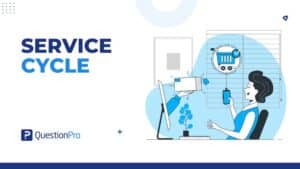
Overview
Online surveys offer unique flexibility in the design of data-collection models that were previously unavailable using traditional methods like phone and paper-based surveys. The dynamic nature of online surveys allows the researcher to design surveys that have a low level of cognitive stress while at the same time being able to collect the necessary data to achieve the research objectives. Online surveys can have relatively complex logic that can adapt to the respondent, based on earlier choices and dive into the reasoning behind the choices. In this article, we’ll explore ways and means of measuring purchase intent and different mechanisms we can use to reduce cognitive stress (make the survey smarter, shorter, easier to comprehend, and interactive) while still collecting the data required to make smart decisions.
Measuring Purchase Intent & Price Elasticity

Simply put, measuring purchase intent and price elasticity can help you determine the “optimal” price for a particular product or service. In general, as with any consumer-oriented product or service, an increase in price leads to a decrease in volume (purchase intent.) The idea here is to accurately model the inverse relationship (if it exists) and the price band it exists in. For example, there may be no relationship (between price and purchase intent) in products and services that are heavily based on brand perception. A good example is the sale of luxury cars – The prices of luxury cars do not affect purchasing decisions as much as brand loyalty and brand relation. Accordingly, the luxury car makers do not compete with each other on price – they compete on brand measurement.
There are many ways and models established for measuring purchase intent and price elasticity. In this article, we’ll show you one such model that we believe is ideal for consumer-oriented products. The reason we chose consumer-oriented products is that consumer surveys pose a unique challenge for researchers – online self-administered surveys taken by average consumers have to be:
a) Simple
b) Concise
c) Precise
This adds a dimension of simplicity that may run contradictory to the research objectives that you may have in mind. However, with dynamic online surveys, we believe that this risk can be mitigated and the data collected via simple online surveys can be used to determine purchase intent and price elasticity.
The Funnel Model
The Funnel Model consists of two simple ideas:
a) Identifying purchasing behavior
b) Determining the price band and purchase intent
Continuing along with our simplicity theme, the easiest way to identify purchasing behavior is to ask the respondents to choose the brands/entities he has/would purchase. This could be as simple as a multiple-choice (multiple-option) checkbox question that asks users to choose all the brands/products that they would purchase in the next 3-6 months.
Example:
Please choose (you can choose more than one) the fast-food places you’ve been to in the last 6 months:
a) Burger King
b) McDonalds
c) Wendys
d) Carls Jr
e) Jack In the Box
This questioning model gives us three important cues:
a) Brand Market Share – This must validate with other research sources to make this study valid. This can be used as a validating and calibrating mechanism for your respondent sample. For example, if the survey goes out to consumers in the US-West Coast not all the fast food brands may be represented here.
b) Funnel Filter – The multiple-choice format also allows you to now determine future questions based on how each respondent has answered this question. This question can now act as a driver to our subsequent questions for measuring the price elasticity and measuring purchase intent. In QuestionPro software terminology this is your “source extraction” question.
c) TURF Analysis – TURF analysis on multiple choice (multiple answer) questions can give you insight into the unduplicated reach. A full explanation of TURF is beyond the scope of this article. For a full detailed description please see:
For example, in this case, TURF will give you the fast-food chains that have the highest reach. This can get especially interesting if more than one brand is owned by the same company.
The Elasticity Question – Brand Equity
The elasticity question is a matrix question that has a range of price points that you want to test out. The items in the x-axis are the various price points and the items in the y-axis are the selected brands forwarded from the previous funnel question. It is generally advisable that the price ranges be consistently incrementing or decrementing. Here is an example:
All things being equal, how much would you pay for a value burger meal with fries and a medium drink?
We have a few important observations here:
a) Extraction: The Brands that are carried over (Burger King, Wendy’s) are the ones that the respondent has selected in the funnel question.
b) Permanent Anchor: You can add in a new brand/product to measure what the addition of a new product can do to the mix. This option can be anchored permanently so that it is always asked relative to the options that the users choose. In our example above, “Description of New Product” is the new anchored option.
c) No-Choice Option: An N/A option should be present that allows users to say that none of the price points are acceptable. This is extremely important as it follows the cardinal rule of all self-administered surveys – they have to be mutually exclusive and exhaustive. The N/A option satisfies the exhaustive part of the rule.
d) Price Band: The price band is from $2.99 to $4.99 in this example. Your actual values probably will be different depending upon your measurement parameters. In general, it is advisable that the range is consistent (in this case a standard $.50 increase.)
Quick Implementation Guide
Step 1: Create the Funnel Question
Use the Question Wizard to add a Multiple Choice (Checkbox) question.
Step 2: Create the “Extraction Question”
Use the “Extraction” feature on the funnel question to extract to a matrix question.
Step 3: Edit the extraction question to add/update the price points
Step 4: Edit the extraction question to add in a constant anchor (new product etc.) if needed. Make sure you do not delete the extracted options.
Analytical Measurement of Price Elasticity
Once you have administered the survey, we can see the kind of analysis that can be performed. You may choose to add other questions in the survey depending on what else you want to measure. However, keep in mind that keeping surveys short and simple is your best bet to having high response rates.
Given our current setup, a relative frequency percentage can be calculated very easily for each of the price-points for each of the brands. QuestionPro’s standard and basic reporting features can tabulate this data automatically for you. For example, you can find out what percentage of the users who chose Burger King as one of the funnel questions chose $2.99 as the price point for the value meal. The same applies for $3.49, $3.99 and so on and so forth. Thus mechanically you can find out (on a per/brand basis) the price point that gives you the maximum count. For example, if the frequency distribution for Burger King is as follows:
2.99 56%
3.49 20%
3.99 14%
4.49 7%
4.99 2%
N/A 1%
Now, lets us interpret this data:
If the price is at $2.99, you’ll get purchase intent of 99% (56% + 20% + 14% + 7% + 2%.) This is because; it can be assumed that users who choose $3.49 will readily pay $2.99 for the same product. Although this is not a universal rule, we can assume this to be true for consumer oriented (price conscious) products.
If the price is at $3.99, the purchase intent drops to 23% (14% + 7% + 2%)
If the price is $4.99 the purchase intent is 2%.
We obviously discard the “N/A” option where users essentially reject all the available options. You may be able to run preliminary studies to make sure that the N/A option is not chosen by more than 5-10% of the respondents. If you see more respondents choosing this option, you must re-calibrate the price band to make sure it is in line with respondent’s expectations. If most of the respondents start choosing the N/A option, you will not be able to glean much from the data.
Now we can answer two questions:
a) What is the best price point for this brand?
The best price is simply the option that has the highest relative frequency. This simply means that, at this price point, you have the highest probability of attracting the most number of customers to purchase your product. In general, this would be your cheapest option available.
b) What is the most optimal price point?
The best price may not get you the optimal price. The optimal price is where the actual value (profitability) is the best. The first thing you need to determine the optimal price is the “profitability” for each of the price points. Let us call this measurement of relative profitability.
In many cases, you can simply use the price itself as a profitability indicator. To determine profitability, simply multiply the column 1 values with column 2. In this case, multiply 2.99×56%, 3.49×20% etc. – This is under the assumption that the profitability is the same as the price. In cases where you can determine the profitability at each price point, use that number. For example, if we knew that the cost to produce a burger in our scenario is $1, we would subtract $1 from each of the price points before determining the relative profitability.
Once relative profitability is determined, the price point that has the highest value is the optimal price point. In our example.
Relative Profitability
2.99 56% 1.67
3.49 20% .69
3.99 14% .55
4.49 7% .31
4.99 2% .09
N/A 1%
Here our best price is also the optimal price. However, this may not be the case all the time. In many cases you may be able to find a price point although is not preferred by most of your respondents, may give you the best profit.
Currently, QuestionPro does not automatically perform the calculation above (for the relative profitability.) However, this is a very trivial exercise that you can perform in Excel by simply copying and use the values generated by the Summary Report and writing a cell function to multiply values in column 1 with values in column 2 to calculate the relative profitability. You can even use the Excel Report generated by QuestionPro as the basis for performing this calculation.
Conclusion
We believe that this ability to quickly and cost-effectively determine price elasticity for a particular industry segment gives you the ability to make decisions more effectively and with much more confidence. We would like to point out a couple of important caveats:
a) As with all self-administered surveys, the quality of the data is largely dependant on the quality of the sample. If your respondent sample does not reflect your customer base the analysis will be incorrect.
b) This model works well where there are relatively few attributes affecting the purchase decision. The price being the most important and the dominant among all the attributes. Conversely, this model does not work well where there are a lot of differentiating features that the market-space relies on. In such cases, a more in-depth conjoint analysis type study may be more appropriate.







